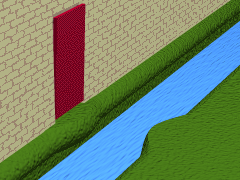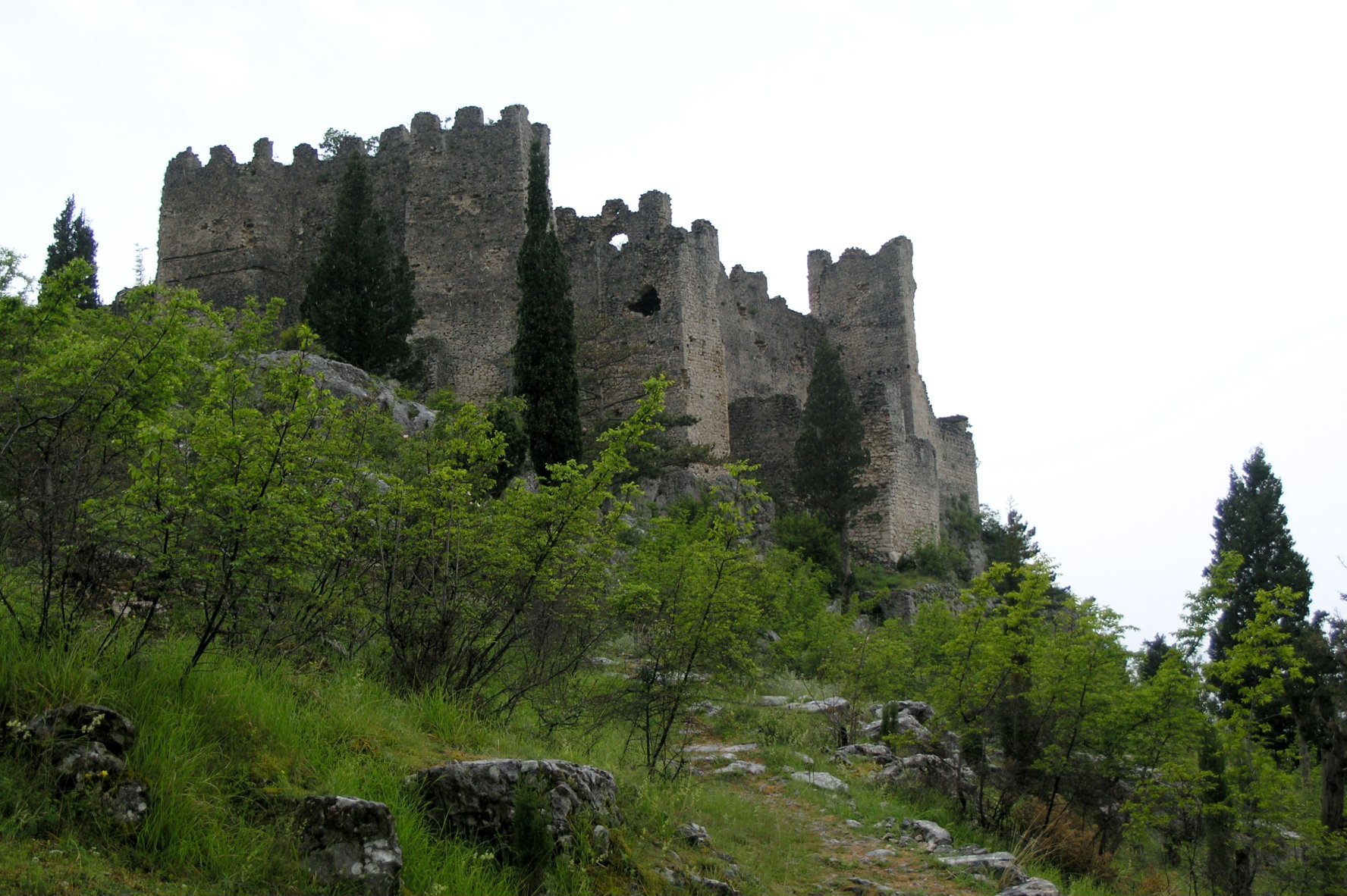|
Komotin Fort
Komotin Castle is a ruined castle in Bosnia and Herzegovina, in the Jajce Municipality. Background Komotin is believed to have been built in the early 14th century. The last Bosnian King Stephen Tomašević issued a charter which gave Komotin to his uncle Radivoj Kotromanić. The architecture shows that komotin was a manorial court, but its positioning high on a hill that was difficult to access other than by narrow winding paths made it easily defendable. Once intruders and invaders had gotten up the path they then had a moat to contend with that could only be crossed by drawbridge A drawbridge or draw-bridge is a type of moveable bridge typically at the entrance to a castle or tower surrounded by a moat. In some forms of English, including American English, the word ''drawbridge'' commonly refers to all types of moveable b .... The walls of the manor were between thick, with a rectangular shape. Within the walls was also a large and small bailey, plus quarters and accom ... [...More Info...] [...Related Items...] OR: [Wikipedia] [Google] [Baidu] |
Jajce
Jajce ( sr-Cyrl, Јајце) is a town and municipality in the Central Bosnia Canton of the Federation of Bosnia and Herzegovina, an entity of Bosnia and Herzegovina. According to the 2013 census, the town has a population of 7,172 inhabitants, with 27,258 inhabitants in the municipality, It is situated in the region of Bosanska Krajina, on the crossroads between Banja Luka, Mrkonjić Grad and Donji Vakuf, on the confluence of the rivers Pliva (river), Pliva and Vrbas (river), Vrbas. History Ancient times Jajce Mithraeum is a temple dedicated to the God of the Sun, Mithra. The god was worshiped and the cult spread to other parts of the Roman Empire throughout the Mediterranean basin by slaves and merchants from the Orient, and by Roman soldiers who came into contact with the followers of the cult in the East. The temple is dated to the 2nd century AD and was renovated sometime during the 4th century AD. This particular Mithraeum is renowned as one of the best preserved in Europe. ... [...More Info...] [...Related Items...] OR: [Wikipedia] [Google] [Baidu] |
Bosnia And Herzegovina
Bosnia and Herzegovina, sometimes known as Bosnia-Herzegovina and informally as Bosnia, is a country in Southeast Europe. Situated on the Balkans, Balkan Peninsula, it borders Serbia to the east, Montenegro to the southeast, and Croatia to the north and southwest, with a coast on the Adriatic Sea in the south. Bosnia (region), Bosnia has a moderate continental climate with hot summers and cold, snowy winters. Its geography is largely mountainous, particularly in the central and eastern regions, which are dominated by the Dinaric Alps. Herzegovina, the smaller, southern region, has a Mediterranean climate and is mostly mountainous. Sarajevo is the capital and the largest city. The area has been inhabited since at least the Upper Paleolithic, with permanent human settlement traced to the Neolithic cultures of Butmir culture, Butmir, Kakanj culture, Kakanj, and Vučedol culture, Vučedol. After the arrival of the first Proto-Indo-Europeans, Indo-Europeans, the area was populated ... [...More Info...] [...Related Items...] OR: [Wikipedia] [Google] [Baidu] |
Jajce Municipality Location
Jajce ( sr-Cyrl, Јајце) is a town and municipality in the Central Bosnia Canton of the Federation of Bosnia and Herzegovina, an entity of Bosnia and Herzegovina. According to the 2013 census, the town has a population of 7,172 inhabitants, with 27,258 inhabitants in the municipality, It is situated in the region of Bosanska Krajina, on the crossroads between Banja Luka, Mrkonjić Grad and Donji Vakuf, on the confluence of the rivers Pliva and Vrbas. History Ancient times Jajce Mithraeum is a temple dedicated to the God of the Sun, Mithra. The god was worshiped and the cult spread to other parts of the Roman Empire throughout the Mediterranean basin by slaves and merchants from the Orient, and by Roman soldiers who came into contact with the followers of the cult in the East. The temple is dated to the 2nd century AD and was renovated sometime during the 4th century AD. This particular Mithraeum is renowned as one of the best preserved in Europe. It was discovered accidentall ... [...More Info...] [...Related Items...] OR: [Wikipedia] [Google] [Baidu] |
Stephen Tomašević
Stephen or Steven is an English first name. It is particularly significant to Christians, as it belonged to Saint Stephen ( ), an early disciple and deacon who, according to the Book of Acts, was stoned to death; he is widely regarded as the first martyr (or "protomartyr") of the Christian Church. The name, in both the forms Stephen and Steven, is often shortened to Steve or Stevie. In English, the female version of the name is Stephanie. Many surnames are derived from the first name, including Stephens, Stevens, Stephenson, and Stevenson, all of which mean "Stephen's (son)". In modern times the name has sometimes been given with intentionally non-standard spelling, such as Stevan or Stevon. A common variant of the name used in English is Stephan ( ); related names that have found some currency or significance in English include Stefan (pronounced or in English), Esteban (often pronounced ), and the Shakespearean Stephano ( ). Origins The name "Stephen" (and its comm ... [...More Info...] [...Related Items...] OR: [Wikipedia] [Google] [Baidu] |
Radivoj Of Bosnia
Radivoj of Bosnia ( sh-Latn-Cyrl, separator=/, Radivoj Ostojić, Радивој Остојић; died in late May or early June 1463) was anti-king of Bosnia from 1432 until 1435, when he lost all control over the kingdom but did not relinquish the title, and again from 1443 until 1446, when he abandoned his claim. He was recognized as king by the Ottoman Empire and the Despotate of Serbia, as well as by the Bosnian noble houses of Kosača and Pavlović, but never by the West. Radivoj is thus seldom included in the list of rulers of Bosnia. Background Radivoj was the older of the two illegitimate sons of King Ostoja. He was most likely born before 1410, during Ostoja's marriage to Kujava Radinović, the mother of the King's only legitimate son, Stephen Ostojić. Like his younger brother Thomas, Radivoj was a doubly adulterine child, as his father confessed to the pope that their mother too had a living husband at the time of their births. The surname Kristić (or Krstić or Hrst ... [...More Info...] [...Related Items...] OR: [Wikipedia] [Google] [Baidu] |
Moat
A moat is a deep, broad ditch dug around a castle, fortification, building, or town, historically to provide it with a preliminary line of defence. Moats can be dry or filled with water. In some places, moats evolved into more extensive water defences, including natural or artificial lakes, dams and sluices. In older fortifications, such as hillforts, they are usually referred to simply as ditches, although the function is similar. In later periods, moats or water defences may be largely ornamental. They could also act as a sewer. Historical use Ancient Some of the earliest evidence of moats has been uncovered around ancient Egyptian fortresses. One example is at Buhen, a settlement excavated in Nubia. Other evidence of ancient moats is found in the ruins of Babylon, and in reliefs from ancient Egypt, Assyria, and other cultures in the region. Evidence of early moats around settlements has been discovered in many archaeological sites throughout Southeast Asia, including ... [...More Info...] [...Related Items...] OR: [Wikipedia] [Google] [Baidu] |
Drawbridge
A drawbridge or draw-bridge is a type of moveable bridge typically at the entrance to a castle or tower surrounded by a moat. In some forms of English, including American English, the word ''drawbridge'' commonly refers to all types of moveable bridges, such as bascule bridges, vertical-lift bridges and swing bridges, but this article concerns the narrower historical definition where the bridge is used in a defensive structure. As used in castles or defensive structures, drawbridges provide access across defensive structures when lowered, but can quickly be raised from within to deny entry to an enemy force. Castle drawbridges Middle Ages, Medieval castles were usually defended by a ditch or moat, crossed by a wooden bridge. In early castles, the bridge might be designed to be destroyed or removed in the event of an attack, but drawbridges became very common. A typical arrangement would have the drawbridge immediately outside a gatehouse, consisting of a wooden Deck (bridge), ... [...More Info...] [...Related Items...] OR: [Wikipedia] [Google] [Baidu] |
Bailey (fortification)
A bailey or ward in a fortification is a leveled courtyard, typically enclosed by a curtain wall. In particular, a medieval type of European castle is known as a motte-and-bailey. Castles and fortifications may have more than one bailey, and the enclosure wall building material may have been at first in wood, and later transitioned to stone. Their layout depends both on the local topography and the level of fortification technology employed, ranging from simple enclosures to elaborate concentric defences. In addition to the gradual evolution of more complex fortification plans, there are also significant differences in regional traditions of military architecture regarding subdivisions into baileys. Upper, lower, middle, inner and outer wards or baileys Baileys can be arranged in sequence along a hill (as in a spur castle), giving an upper bailey and lower bailey. They can also be nested one inside the other, as in a concentric castle, giving an outer bailey and inner bailey. ... [...More Info...] [...Related Items...] OR: [Wikipedia] [Google] [Baidu] |
Castles In Bosnia And Herzegovina
This is a list of fortifications in Bosnia and Herzegovina, including fortresses and castles, arranged alphabetically. Bosnian archaeologist and historian of the Middle Ages, Pavao Anđelić, posited that Bosnia and Herzegovina is a home of great number of forts, fortresses, castles, including a number of Walled city, walled city-fortresses, in various degrees of preservation, and built in different stages of Bosniak history, Bosnian history. According to his research he argued that at least 350 of these edifices exists on the territory of modern-day Bosnia and Herzegovina, most of which was erected by or belonged to a medieval Bosnian state, while small number in its borderlands simply rests on the territories included into modern state of Bosnia and Herzegovina, which was largely unchanged, with few very minor exceptions, since 1878. In his book, the ''Medieval Towns in Bosnia and Herzegovina'', historian of architecture of the Middle Ages in Bosnia and Herzegovina, Husref Redži ... [...More Info...] [...Related Items...] OR: [Wikipedia] [Google] [Baidu] |





